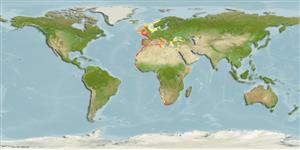| Native range | All suitable habitat | Point map | Year 2100 |

|
| Trachurus trachurus AquaMaps Data sources: GBIF OBIS |
Length at first maturity
Lm 23.9, range 21 - 30 cm
Human uses
Fisheries: highly commercial; gamefish: yes; bait: usually
Phylogenetic diversity index
(Ref. 82805)
PD50 = 0.5001 many relatives (e.g. carps) 0.5 - 2.0 few relatives (e.g. lungfishes)
Trophic Level
(Ref. 69278)
3.7 ±0.0 se; Based on diet studies.
Resilience
(Ref. 69278)
Medium, minimum population doubling time 1.4 - 4.4 years (K=0.12-0.16; tm=2-4; tmax=11; Fec=70,000)